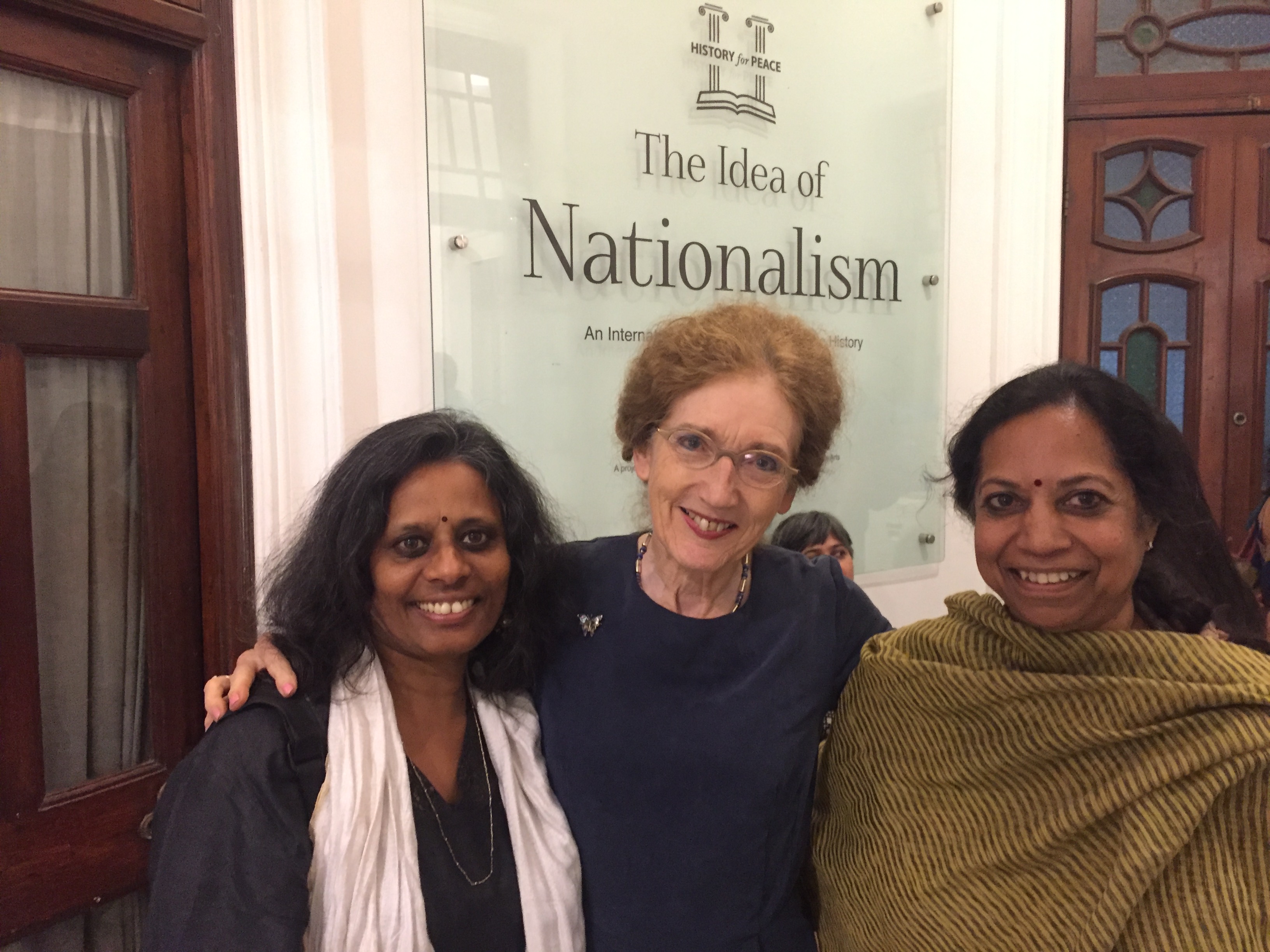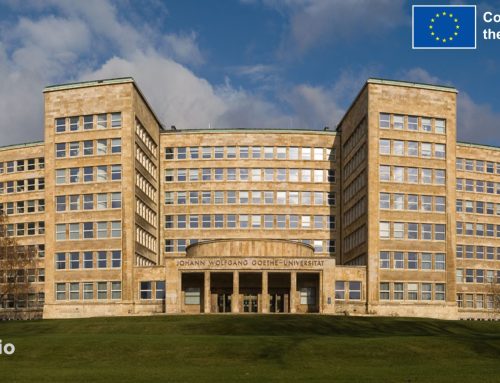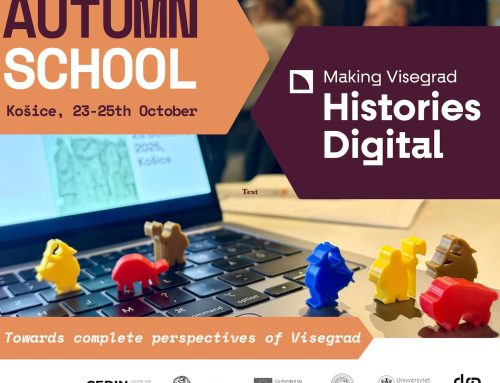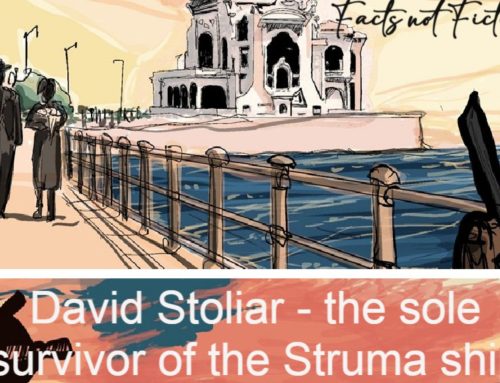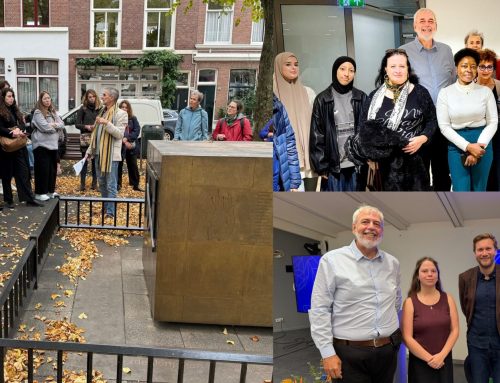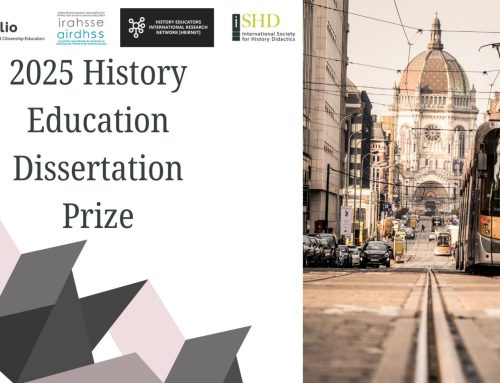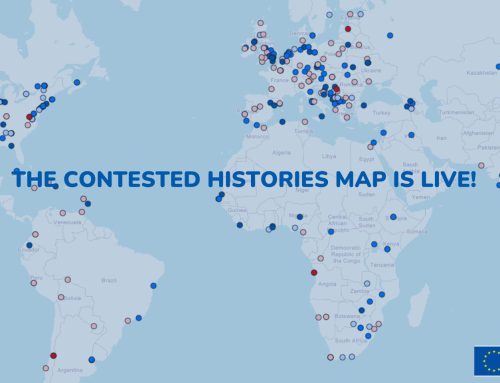This is the first installment of a blogpost on Ineke Veldhuis-Meesters study visit to Calcutta, India, which took place from 6 – 13 November 2016. It is the sixth article in a series of reports and blogposts related to the project “Dealing with the Past in History Education”. The preceding blogpost on Marios Epaminondas’ visit to Korea can be found here.
Report by Ineke Veldhuis-Meester EuroClio Ambassador to the PeaceWorks Directorate and to the Board and Secretariat of EuroClio
PeaceWorks hosted me, Ineke Veldhuis-Meester, EuroClio Ambassador and former Senior Lecturer in History Education at Groningen University, The Netherlands, from 6 to 13 November as part of a study visit which included the International Conference on Teaching History titled ‘The Idea of Nationalism’, from 10 – 12 November 2016 in Calcutta. During the full three conference days I could engage with educators from all over the subcontinent, teachers, speakers, and artists from different parts of India and from the two bordering countries Bangladesh and Pakistan. It was striking that some persons coming from the border area with Pakistan were not at the conference. They had been refused a visa to cross the border due to the ongoing conflicts at the Line of Control in Kashmir, a difficulty we experienced at some EuroClio conferences. The conference atmosphere was warm and informal, the floor was open to a manifold of concepts, thoughts and opinions, backed up by research or experience. Each day, discussion in groups was embedded in the reflection rounds and during the meals. What creates a sense of belonging in a so religiously, ethnically and ideologically diverse thinking people? And how can very distinctive nationalist models in society coexist with blurred visions? It made me think of Benedict Anderson’s imagined communities. Would it be possible that all can shelter under the ‘umbrella concept’ of ‘civic nationalism’ for which professor Anil Sethi entered a plea? It gave me hope: perhaps it could serve as a practical start.
Prior to the conference I got the chance to interact with teachers and students in schools. PeaceWorks organised five highly interesting visits to very different schools/learning Institutions, all part of their network. Programme Officer Paroma Sengupta, accompanied me at the visits, supported by Subhadrika Sen. Our welcome was a heart-warming experience! It was obvious that students and teachers were well known to Paroma by the way she was greeted. I actually tasted the reality of a common school day in a genuinely open atmosphere. Director and staff were very willing to show and explain their plans, visions, solutions and practice. The students were so open to communicate with that it did not seem like it was a first meeting. We started with a talk with the principal/director and one or more leading teachers of the history or social studies department. Subsequently, a staff member accompanied us to show the school and visit parts of several lessons, before I could engage in a talk with teachers and students.
At the Modern Academy of Continuing Education, I introduced EuroClio in 10 minutes and subsequently I conducted a 90 minutes’ workshop for local teachers and teacher trainees on EuroClio’s methodology. In groups of 4/5 they worked hard and had a lively discussion about which concepts and key events of 20th century India to select and how to teach them, especially when there was no agreement on a topic. The teachers and teacher trainees were eager to continue to deliberate and discuss, even though they overran the scheduled time of the workshop. It was also a great experience to meet them again at the conference.
At the conference I presented EuroClio’s mission and approach, under the title ‘History Education- A mirror of pride and pain? In those three days I learned about views on nationalism in the region and heard about policies, noticed the challenges of teaching ideas and different models of nationalism, so different from the European context. Being the only person from Europe I could ask and suggest viewpoints now and then in the discussions following the presentations. In the special reflection groups, I could engage with other participants each day. I saw these reflection groups as an asset for all participants to really get in touch with people’s different experiences and opinions in such complicated matters as teaching ideas of nationalism to better understand a person‘s different position. It was a highly informative and very successful experience. There is a keen interest to build on the idea of EuroClio in India. The study visit aimed at going to the next level; the reports of the visits to schools and the interviews with students and teachers aim to contribute to the EuroClio Project ‘Dealing with the Past in History Education’, in which the director of PeaceWorks herself is involved.
Report and reflections
The History Education Conference was centred on the concept of nationalism. The conference was constructed very well, guiding the thoughts of participants from theoretic concepts to practice in universities, schools, and politics in society. Speeches alternated with discussions and debates in smaller group reflection rounds, accompanied by another speaker in each round.
This first day, I gained many insights. And most remarkable for me was the influence of the colonial period on the constructs of nationalism and the pain of the partition from 1947 on. The effects of partition are still felt today as is the pain of ‘the war of 1971’ – differently named in Indian, Pakistani and Bangladeshi textbooks. Secondly the fact that there are so many diverse peoples and languages in the subcontinent, who have different histories and have been approached and used differently by the British. The openness of the participants towards me struck me as well; teachers of schools I visited the days before, introduced me to colleagues, and the teacher trainees who visited the workshop sought my company.
The second day dealt with nationalism and Leftists. Society and government were topics in the ensuing lively discussion. In the keynote address, professor of history at Jawaharlal Nehru University (JNU), Janaki Nair, reported what happened when they introduced a methodological change from a straight narrative to the introduction of sources and interpretation at schools. The changes were introduced in 2005 in the textbooks developed by the NCERT (National Council of Educational Research and Training). Students should research, read and write, debate and discuss. But students and teachers were not familiar with a more thematic textbook with more uncertain answers, it led to confusion and some lack of understanding about the curriculum demanded. The relative unpreparedness of teachers and students alike made them look for the pillars of knowledge: that was just the counter effect of what was aimed for. Janaki Nair went on to discuss the events that took place in JNU in February 2016.
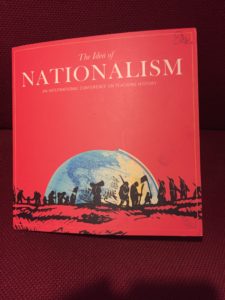
Booklet on “The Idea of Nationalism” (Image provided by Ineke Veldhuis-Meester)
In this context I quote prof. Janaki Nair: “The JNU wanted critical thinking but not the sentiment. However, the predicament of history in India is that it is in the public domain.” The Teach-ins called virulently for respect for listening. “There is much to be gained by listening”. It was such a fascinating story of protest and brave determination to bring about a debate, and perseverance, despite police presence. These ‘JNU Alternative Classroom’ lectures on the historical theories of Indian and non-Indian post-colonial nationalism were spoken partly in English, partly in Hindi and recorded on You Tube. I was so intrigued by this process of debating the challenges of nationalism in public, in spite of the critics from the side of university to government and media, that when I arrived back home, I viewed all the English spoken lectures on You Tube. Deeply impressed, I realised how incomparable the processes of nation building in India and Europe are. And at the same time I recognised comparable phenomena: also in European history, nationalists pick out the parts of history that suit the creation of their myths and support their power, or even invent them, from the 19th century until present day. Janaki Nair told us that questions were raised such as: Can nationalism solve the casts issue [for Europe the class issue], the multi-linguistic problem, the multi-ethnic issue? Is the nation the same as the state? What about the government? What is the role of the military in protecting the nation? And how do we teach to children the dilemma of the different concepts of nationalism, when they hear at home THE one vision of their parents or group nationalism?
Professor Anil Sethi pleaded in his talk “Is Nationalism a dubious Construct?” for adaptation of an inclusive concept of civic nationalism in which belonging is the ‘civicness’ of the sovereign people. This concept takes nationalism away from violence and war seeking concepts of religious, ethnic and ideological nationalism and down the civic nationalist route. At our reflection table he warned that you need to work on it constantly to create inclusive values by being politically vigilant and developing a critical attitude toward the state as a good patriot. He spoke about ‘enfranchising’, I think it meant here emancipating the ‘lower class people’ and giving them a position as citizens with a voice.
At the end of the day the author Jerry Pinto illuminated in a humorous story, Bollywood as National(ist) Cinema, the influence of popular culture on your idea of nationalism. How the images in romantic films imperceptibly creep in your mind, like the ‘Mother India’ image as the all-sacrificing woman, or what the picture means of a girl saying ‘No’ to a man: ‘only that she needs to be persuaded’. This is what I remember, the audience recognised every characteristic, as proved by bursts of laughter. The last lecture by Deepa Sreenivas titled ‘ Sculpting the Citizen: History, Pedagogy and the Amar Chitra Katha’ explained how well known illustrated books for children- the Amar Chitra Katha series- contribute to recovering Indian tradition for middle class children.
This second day ended with another aspect of the Indian history: a ceremony on the premises of a government building, a speech by the cultural historian and culture secretary, Jawhar Sircar, on The Slow Silent Emergence of a pan-Indian National Identity. I felt we were taken back to the first years after the old colonial times. The speech was held in memory of Maulana Azad, a political leader of the Indian independence movement and the first minister of Education under Nehru. Afterwards we were treated to delicious Indian food on the balcony of the Maulana Abul Kalam Azad Museum devoted to Maulana Azad. The Maulana Abul Kalam Azad Institute of Asian Studies (MAKAIAS) hosted the dinner and talk. It was a special Indian cultural evening.
The third day was devoted to “Thinking Beyond Borders”, introduced by a keynote address of Malini Sur, a senior research fellow at the Western Sydney University, on the Bangladeshi-Indian border. Under the heading Nationalism, Borders and Construction: Voices from the Ground the rest of the day was devoted to oral histories of the border areas and visual stories articulated in graphic novels, film and popular (calendar) art. What was similar, what was different and why? It was obvious that in India there are hardly any public Muslim images and no references to politics, but multiple Hindu religious figures are depicted, connected with Indian nationhood and strength. In Pakistan, posters depict the typical father of the nation images or present day views of the ancient religious cities.
The last reflection round concentrated on what to take home, how to bring the multiple perspectives of the topic ‘nationalism’ into the classroom. Valuable suggestions were given, e.g. initiatives for exchange of programmes via internet, interviewing each other over the border, developing learning exercises about the same film or video material on both sides of the border that would itself lead to more different opinions allowing for discussion.
In conclusion of this first part of the blogpost: The study visit was a great and successful learning adventure, with school visits as a highlight. I was very happy with the varied selection of the schools. I learned a lot about needs and practices of the schools according to their different systems and different socio-economic backgrounds. I felt especially inspired by what I saw happening in the schools, by their staff’s endeavours, by the positive atmosphere in all five institutions I visited. I experienced schools with happy children and energetic staff members, who aimed at teaching their pupils/students knowledge and understanding in a very stimulating manner. It also covered children of varying ages and social backgrounds to develop their talents and acquire skills to become worthwhile citizens. Through this process, understanding your own history and knowing something about world history was considered an essential element. The intellectual atmosphere and debate without inhibitions as well as the cordial way of receiving me in their midst made the conference for me not only a source of learning but also a joy to attend.
Groningen, 20 February 2017, part I
This concludes first part on the report of Ineke Veldhuis-Meesters study visit to Calcutta. A more detailed report on the school visits and question and answer rounds will be available in the second part of this blogpost. This study visit has been a part of the project “Dealing with the Past in History Education”, supported by the Robert Bosch Stiftung. For more information on this project, please visit the project page.

